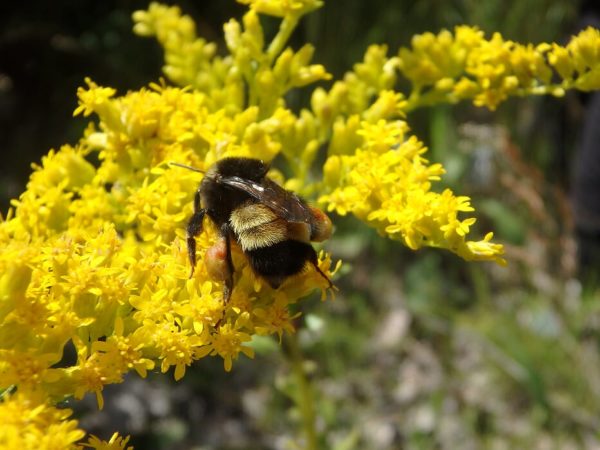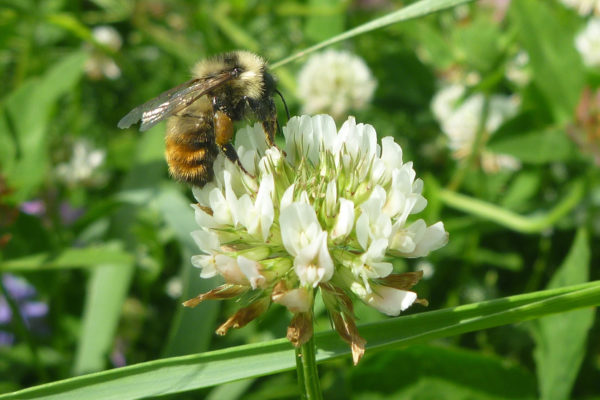Bee photos by community scientists contribute to much needed data for conservation efforts
TORONTO, June 29, 2020 – Think you can identify that bumble bee you just took a photo of in your backyard? York University researchers have found that a little more than 50 per cent of community science participants, who submitted photos to the North American Bumble Bee Watch program, were able to properly identify the bee species.
Community science is a popular tool used by conservation biologists to engage the public in scientific data collection to inform conservation policy and management decisions.

Bombus terricola. Photo credit: PhD candidate Victoria MacPhail, Faculty of Environmental Studies, York University
In the case of Bumble Bee Watch, the collected data is from all over North America and can feed into conservation plans to better protect the bees and their habitats, and even to know what habitats they need, knowledge on how different species are doing, and even legal protections for endangered bee species. Tens of thousands of bees have been recorded, including those at-risk.
“That data is incredibly important. It’s data that would otherwise may not be captured,” says PhD student Victoria MacPhail of the Faculty of Environmental Studies (FES) and lead author of the study published today in the journal PeerJ.
But if the bee identifications made by the public are inaccurate close to 50 per cent of the time, that puts a lot of strain on the enlisted experts to verify or correct the identifications.
“Accurate species level identification is an important first step for effective conservation management decisions,” says MacPhail. “Those community science programs that have experts review submitted photos to determine if the identification is correct have a higher scientific value.”

Bombus rufocinctus. Photo credit: PhD candidate Victoria MacPhail, Faculty of Environmental Studies, York University
There are 46 species of bumble bees in North America. Community scientists collected or identified about 39 species, although not always correctly. Some of the species the participants were most likely to get wrong were the Rusty-Patched Bumble Bee and the American Bumble Bee. Both are declining and listed as critical or of special concern. MacPhail thinks much of that has to do with wishful thinking.
“Everyone wants to find an endangered bumble bee in their backyard,” she says. “But the accuracy of initial identification is important for determining the utility and quality of community science-collected data.”
The researchers, including Assistant Professor Sheila Colla of FES and PhD student Shelby Gibson of the Faculty of Science, analyzed more than 22,000 expert-reviewed submissions to Bumble Bee Watch. Some 52 per cent were correctly identified by species, 38 per cent were incorrectly identified, while another nine per cent were invalid (not a bumble bee).
Some species are easier to identify than others, which is why the researchers are looking into the possibility of using artificial intelligence to verify submissions of those easier-to-identify bees. They will also look at providing more tools and resources to help participants properly identify the bee in their photos, including pop-up windows to offer tips on what to look for to identify that particular species before the final submission is made.
Better accuracy of identification means the data can be put to use faster and it will save valuable expert time, allowing them to give more timely feedback, engage participants, enhance educational value and aid in retention of the valuable resource of community scientists.
PHOTOS:
Volunteers taking photos of bees – https://news.yorku.ca/files/Bumble-Bee-Watch-Volunteer2.jpg Credit: PhD candidate Victoria MacPhail, Faculty of Environmental Studies, York University
https://news.yorku.ca/files/Bumble-Bee-Watch-Volunteer3.jpg Credit: PhD candidate Victoria MacPhail, Faculty of Environmental Studies, York University
Bees on flowers –
https://news.yorku.ca/files/rufocinctus-P1460236.jpg Bombus rufocinctus. Credit: PhD candidate Victoria MacPhail, Faculty of Environmental Studies, York University
https://news.yorku.ca/files/bohemicus-Sheila-Colla.jpg Bombus bohemicus. Credit: Assistant Professor Sheila Colla, Faculty of Environmental Studies, York University
https://news.yorku.ca/files/Bumble-Bee-Watch-terricola-goldenrod.jpg Bombus terricola. Credit: PhD candidate Victoria MacPhail, Faculty of Environmental Studies, York University
-30-
York University champions new ways of thinking that drive teaching and research excellence. Our students receive the education they need to create big ideas that make an impact on the world. Meaningful and sometimes unexpected careers result from cross-disciplinary programming, innovative course design and diverse experiential learning opportunities. York students and graduates push limits, achieve goals and find solutions to the world’s most pressing social challenges, empowered by a strong community that opens minds. York U is an internationally recognized research university – our 11 faculties and 25 research centres have partnerships with 200+ leading universities worldwide. Located in Toronto, York is the third largest university in Canada, with a strong community of 53,000 students, 7,000 faculty and administrative staff, and more than 300,000 alumni. York U's fully bilingual Glendon Campus is home to Southern Ontario's Centre of Excellence for French Language and Bilingual Postsecondary Education.
Media Contact:
Sandra McLean, York University Media Relations, 416-272-6317, sandramc@yorku.ca

